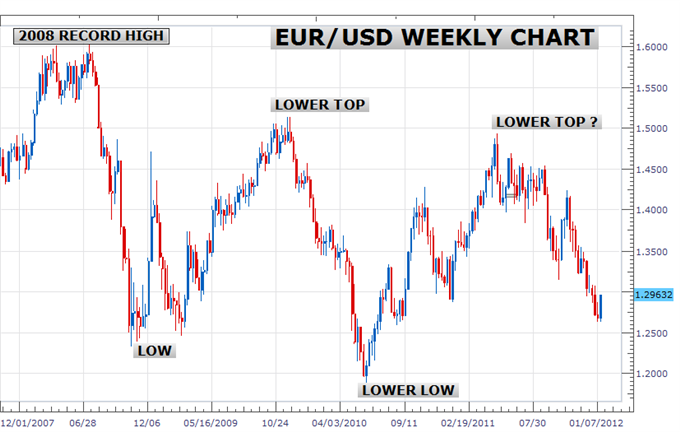The Euro finds itself at a potential crossroads.
Does the single currency zone remain intact and prove that the Euro itself is a viable currency?
Does the single currency zone remain intact and prove that the Euro itself is a viable currency?
Do Germany and other core nations come in
to rescue the periphery despite significant domestic opposition?
As it
stands, recent trends plainly point to continued turmoil and further
Euro losses.
Yet a lot can happen in six months, and it will be crucial
to monitor developments in the Euro Zone in the first half of 2012 and
how it affects the Euro exchange rate.
We foresee Euro declines in the first half of 2012.
How low can we go?
Many factors will affect this, but we expect to see
Euro/Dollar (EUR/USD) to reach at least 1.20 in the next six months, and
perhaps even touch 1.15.
Debt Crisis Front and Center
The current European debt crisis started with
serious doubts over Greek debt as early as 2009, but 2011 marked the
year in which worries over the periphery spilled into the Euro Zone
core. Whereas previous debt problems had been limited to the
comparatively small Greek, Irish, and Portuguese economies, trader
worries transferred into core nations as tensions hit fever pitch.
Investors aggressively sold Italian and Spanish
bonds as they doubted the solvency of governments in the Euro Zone’s
third and fourth-largest economies. Italy, the Euro Zone’s third-largest
economy, has total public debts representing over 120 percent of
domestic Gross Domestic Product. With such an enormous debt load, it is
important to watch the interest rates that Italy must pay on its debt.
If it must pay unsustainably high interest rates – believed to be around
7% for 10-year bonds, which was seen on several days in November and
December – Italy may be pushed beyond the point of “no return”. That is
to say, it will depend on external aid to remain fully solvent.
What could conceivably put Italy on the right path
and stave off a fiscal crisis on a scale few could imagine? The first
step must be a credible plan for Italy to meet its debt
obligations—likely led by strong fiscal austerity and real commitment to
economic reforms to enhance productivity. The new Italian government
has announced measures to cut deficits via increased taxes and reduced
spending. Of course such deficit-cutting measures are complicated by the
fact that the Italian economy remains stuck in a period of extremely
low growth. In the period from 2000 to 2010, Italy held the third-lowest
GDP growth rate in the world behind Haiti and Zimbabwe.
The short-term budget cutting measures that have
been taken thus far have proven insufficient and perhaps even
counterproductive. The entire Euro Zone is now expected to enter a
recession through the first quarter of 2012, and any aggressive spending
cuts and/or tax increases from Spain and Italy could exacerbate the
downturn.
The new conservative government in Spain has
announced fairly aggressive deficit-cutting measures that have been met
with noteworthy improvements in domestic bond prices, and hence lower
interest rates. Yet the spread between 10-year Spanish bond yields and
the benchmark German equivalent continues to trade near its widest
levels since the Euro’s inception. Markets seem more optimistic, but the
overwhelming theme is pessimism over the solvency of key Euro Zone
governments.
The unvarnished truth is that an orderly solution to
Euro Zone fiscal woes seems exceedingly unlikely. Ideally we would see
commitments to real structural changes in regional governance. For
example, markets might be more likely to lend to Italy and Spain if all
Euro Zone nations were prohibited from running budget deficits beyond a
certain level. Such rules have existed for years in the form of the Euro
Zone’s “Growth and Stability Pact”, but the missing link remains the
lack of real consequences for non-compliance. We foresee a continuation
of the trend of patchwork short-term solutions that continue to roil
financial markets. Such initiatives may involve attempts at Italian
fiscal austerity, European Central Bank aid, and/or international aid.
Yet the problems of Euro Zone debt and competitiveness will remain
significant.
As traders, we will look for opportunities to play
ongoing crises through the Euro/Dollar (EUR/USD) exchange rate. Although
shorter-term rallies as high as $1.3500 seem possible, the overall
trend favors further EURUSD weakness.
Medium-term technical studies point to more Euro weakness
A closer look at the longer-term chart shows the
market locked in a well defined downtrend since posting record highs
just over 1.6000 back in 2008. An initial low was recorded in October
2008 by 1.2330, followed by a lower top at 1.5145 in November 2009, a
lower low at 1.1875 in June 2010 and the latest anticipated lower top by
1.4940 in April 2011. The failure to move higher in 2011 opens the door
for the current downside extension which should ultimately look to
retest and eventually break below the 1.1875, June 2010 lows. This would
confirm the next lower top at 1.4940 and potentially point towards a
deeper drop towards 1.1500.

As such, our outlook for the first half of 2012 is
predominantly bearish while the market adheres to the broader underlying
downtrend, and we would expect to see a move towards 1.1875 at a
minimum before considering the potential for any meaningful recovery. In
the interim, any rallies should therefore continue to be very well
capped, with overbought short-term rallies viewed as compelling
opportunities to look to build on short positions. Ultimately, only a
2-week close back above 1.3500 would bring this outlook into question
and give reason for concern.
No comments:
Post a Comment